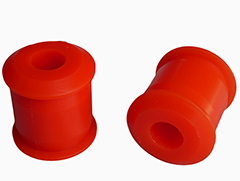Polyurethane bushings Versus Rubber bushings
 What is the difference between polyurethane and rubber
bushings: Polyurethane bushings usually provide better handling, while rubber
bushings have a smoother driving experience. This is a basically correct
explanation, but other pros and cons should be considered when deciding which
bushing to use for a vehicle.
What is the difference between polyurethane and rubber
bushings: Polyurethane bushings usually provide better handling, while rubber
bushings have a smoother driving experience. This is a basically correct
explanation, but other pros and cons should be considered when deciding which
bushing to use for a vehicle.
An important reference to keep in mind when considering the difference between urethane bushings and rubber bushings is that personal driving preferences and the intended use of the vehicle play an important role in the selection. Do you value performance (polyurethane) or comfort (rubber) more.
Polyurethane bushings are harder than rubber, but polyurethane is not the hardest suspension. Unless you are familiar with dedicated track racing, you may not need a rubber bushing with solid metal pins for performance in exchange for much better comfort. This greatly increases noise and vibration, but provides the most sensitive handling.
Rubber almost always provides a quieter and smoother driving experience, and it can increase the vehicle's noise and vibration (NVH). In daily commuting, a better riding experience is the reason for choosing rubber bushings (although they have a shorter service life) and urethane bushings may be more suitable for off-road vehicles or large touring vehicles, because these drivers usually like to "feel." The interaction between the vehicle and the road. Moreover, the service life of Polyurethane bushings is much longer than that of rubber.
The biggest advantage of rubber bushings is also its weakness: it is very flexible, even if there is no heavy body that puts a lot of pressure on the rubber bushings, they are also susceptible to vehicle chemicals, road salt, coastal climate and heat. Polyurethane is a more durable material that can withstand chemicals, heat and other factors that destroy the life of rubber.
In addition to external factors, most of the pressure and torque generated by the bushing position will eventually wear or destroy the rubber. The rubber bushings on the suspension for some special purposes (off-road, trailer-mounted trailers) are more difficult to live longer, which is the reason for them to switch to stronger Polyurethane bushings. Rubber bushings require special tools and professional operations, while Urethane bushings can be easily installed with simple tools. The rubber bushing wrapped in the metal sleeve generally requires a hydraulic press to be removed and installed, while the polyurethane bushing can be installed with simple tools and few tools. Since the polyurethane bushing can be installed DIY, once the rubber bushing is pressed out, the cost of replacing the bushing will be greatly reduced. Even the rubber bushing can be removed by heating.
In general, the choice between rubber and Polyurethane bushings mainly depends on whether the demand is "more comfortable" or "higher performance."
Rubber bushings are the first choice for almost all mass-produced vehicles for two reasons: 1) It is cheap; 2) It can provide the smoothest driving experience. The smooth driving experience of the rubber bushing is more suitable for daily commuting and long-distance driving, while the polyurethane improves the handling, the suspension is more durable, and it is more suitable for modification and track use.










